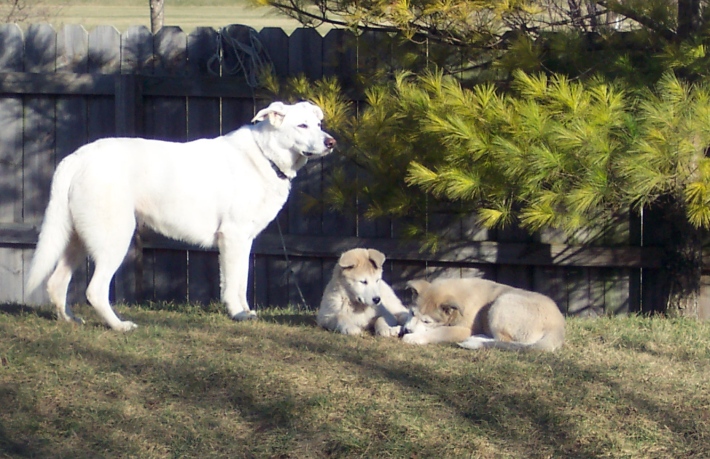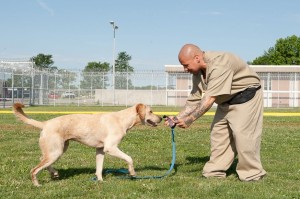Apache was a gorgeous Belgian Shepherd Groenendael. He was my very first dog that I had bought when I was 18 from a backyard breeder. At 8 weeks old, Apache had many behavior issues such as resource guarding. I was trying to do everything right and was consulting with trainers around the area to deal with the issues. My veterinarian had warned me that I should put him down, as the biting was getting worse. But that was not an acceptable option to me and I was determined to find a solution and ‘fix’ the problem.
I was born in Indiana, but spent most of my life in France, right next to the Swiss border. When I was a child, there was no doubt in my mind that I would work with animals when I grew up. Horses were my passion but as far as I can remember, I was always drawn by the desire to help and be around creatures of all kind. As I was trying everything I could to work with my dog I was also familiarizing myself with the world of dog training. I finally decided that this was my calling. I was going to contribute in helping owners and their dogs, diminishing the number of abandoned and euthanized pets! With that goal at heart, I signed up to the most prestigious ‘dog training and psychology’ school at the time, near Paris. After much needed desensitization to some of the techniques, I became the best leash jerker and alpha roller of the facility. I had acquired expertise in most of the available training devices and prong collars and e-collars, had no secret to me. I had become THE Alpha Bitch and could tell any dog ‘who was boss!’
This was close to 30 years ago… Back then, that’s all that training was about. As I started my career and tried helping clients, of course I had good results: I was really good at it! However, many of the results were short lived and the behavior issues came back with a vengeance. In the attempts of helping dog owners, I started realizing how much these techniques were impacting their relationship with their beloved pet.
In the meantime, my dog Apache’s resource guarding had escalated to the point where he had become dangerous, and sadly, with no other option in sight, I had to put him down at the age of two… To this day I still carry the physical scars of this experience on my hands and the psychological scars in my heart…
Following this traumatic development, I opened my eyes one day, realizing that I could no longer work as a dog trainer. This was not acceptable. I was looking to build relationships, trust and confidence in both dogs and their humans. What I was doing was the opposite and the stress created by punitive methods often resulted in more problems. The dog would obey, but unwillingly, and in the process, would learn distrust and experience distress. There had to be better ways for us to relate to our animals.
Ethology was not a well known science in the 80s, and with chance, I stumbled across some of the books written by Konrad Lorenz and Nikolaas Tinbergen. That was it! I decided that I was going to study canines at the scientific level and understand what had gone wrong with my dog Apache and learn how I could help other dogs with similar issues.
I was very fortunate to live only 30 minutes away from the University of Geneva in Switzerland. Jean Piaget, well known for his theories on cognitive development had been one of the tenure professors at the Dept. of Psychology. Prof. Ariane Etienne had been his students and was teaching Ethology at the time. I immediately enrolled and signed up in all the classes that could contribute to my understanding of the animal mind: from Neuroscience to Experimental and cognitive Psychology and finally Ethology. Instead of studying children, I compared the behavior of wolves to that of dogs.
After a few years, Prof. Etienne noticed my passion for her subject as well as my experience of working with dogs. She was running studies on spatial cognition in hamsters and was one of the leading authorities on the subject. She asked me to join her team and develop a new line of experiments on spatial cognition in dogs. The task was exciting but quite challenging since building mazes for dogs is quite different than building experimental apparatus for rodents! I worked with Prof. Etienne’s for close to 10 years during which I completed a Doctorate degree on spatial cognition in dogs.
During that time, I also gathered all the scientific publications on dog behavior that I could find. The scientific world had little interest in dog behavior back then but there were many studies on wolf and other wild canids that could also contribute to better understanding dogs. With the help of Dr Evelyne Teroni, I wrote a book in French, designed to bring the scientific knowledge of the time to the general public (Le Chien Un Loup Civilise).
In the course of my studies, I also started noticing some of the new trends growing in the US, in the dog training field. Karen Pryor had released a video tape, called ‘Clicker Magic’. That video was the answer I was looking for. We didn’t need to force the dogs into position, or show them ‘who’s boss’. Animals of all kinds were learning tricks while having fun! I was starving for more information on this new technique and bought everything on the subject. This was many years ago, so clicker training was in it’s very beginning but I was anxious to bring it to the French public. I immediately created the first French dog training school based solely on clicker training (Animalin, l’Ecole du Chien) and was promoting the technique all over the country and throughout the media. I also created the first French DVD on the subject. After a few years, with the training school going strong, I sold it to Catherine Collignon and moved to the US, where the world of dog training through positive reinforcement was developing quickly all over the country.
I worked as the director of training for a service dog organization in Indiana. Through the power of clicker training and positive reinforcement I taught inmates, men and women who’s life led them down a path of crime and abuse, to develop understanding, psychology and patience with dogs and people. That organization’s mission is twofold: place dogs in the hands of people with disabilities, ranging from autism to mobility issues as well as diabetes, but also help offenders learn a skill that would facilitate their reinsertion into society. For many, this is also the first time they can make a positive difference in someone else’s life.
I’m finally where I had always wanted to be: a factor of improvement of the dog/human relationship.
Jennifer Cattet, Ph.D.





If you are in the EU don’t miss Dr Cattet’s presentation at ICCS in France …http://www.congresmfec.com/
Very impressive story Jennifer! A life dedicated to dogs training methods. Many ups and downs, many successes and fails, but in my opinion this is the right path to a real success in any field of human’s activities. And yes, all animals lear different tricks while having fun, insted of a a brutal methods based on punishment. In my search on the internet for the best method of training for my beloved terrier, which of course should exclude imposition and subordination, I found a northern virginia dog trainer who apply an offleash training method, which I think he’s the man! Thanks all animal lovers who devote their lives to understanding their behavior. Yolanda
This is a very good journey towards becoming a dog trainer & behavioris.Go ahead.Thanks……..
Great article. What kind of distance can I get on these training collars: http://www.trainingcollarstore.com
Great article. What kind of distance can I get on these training collars?